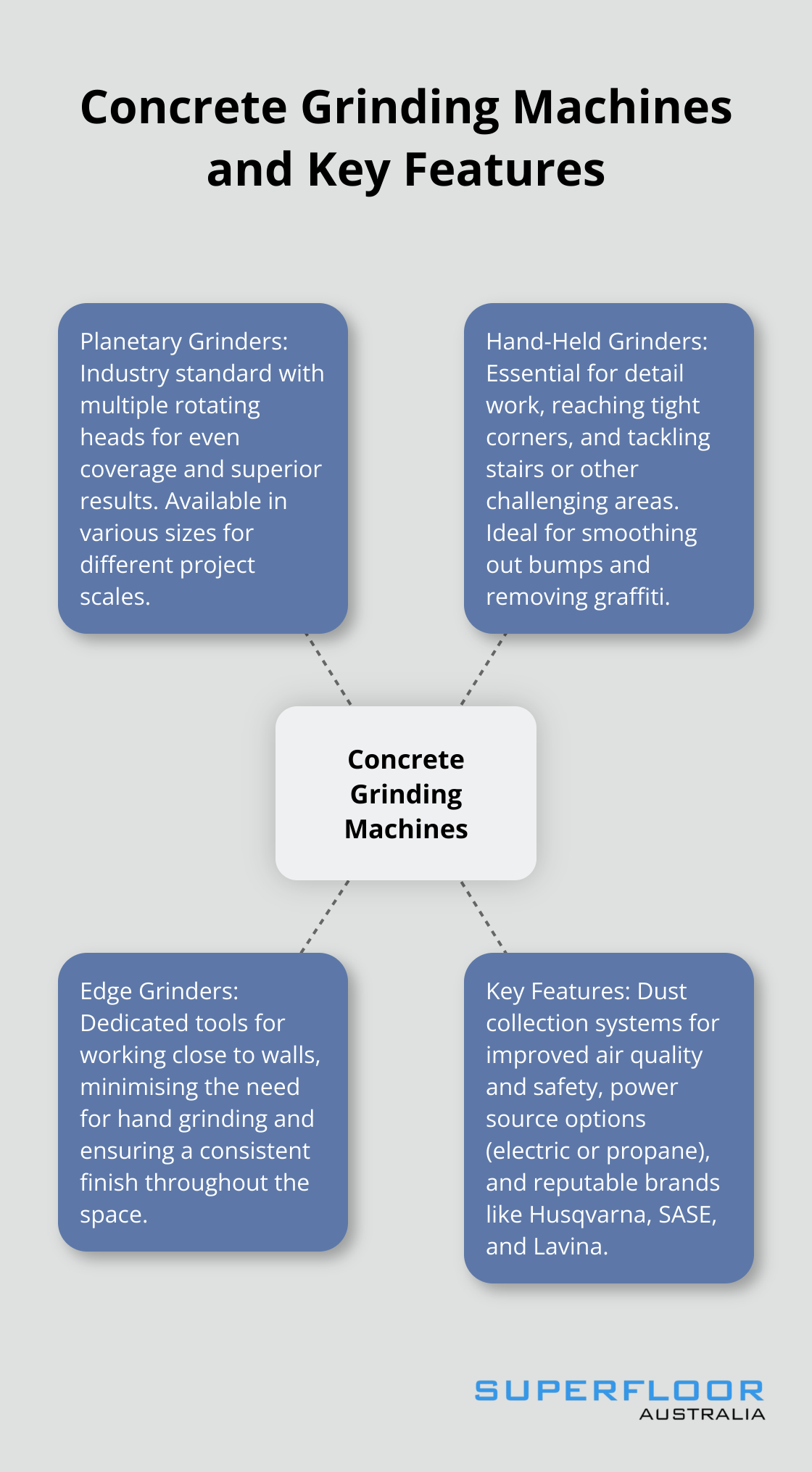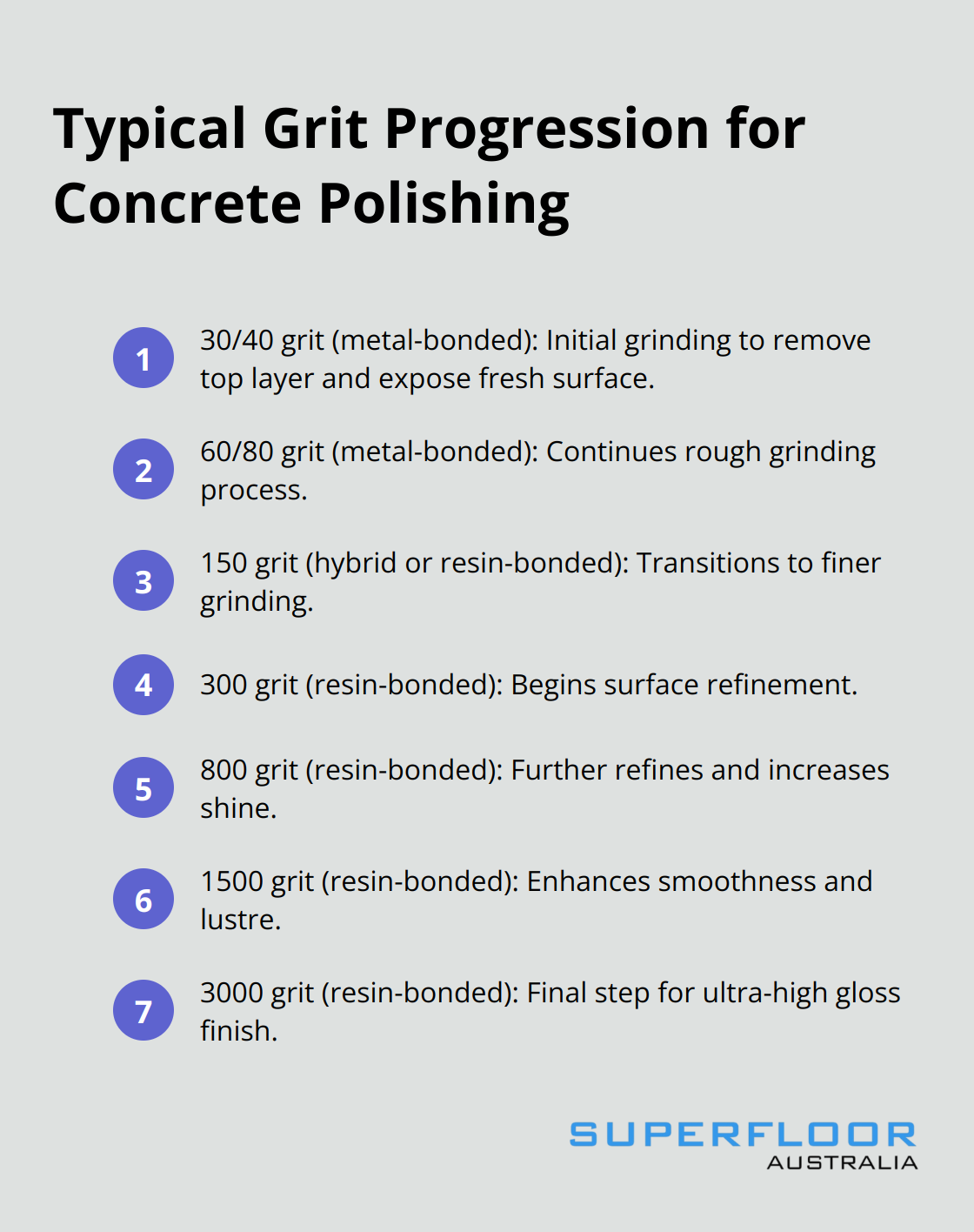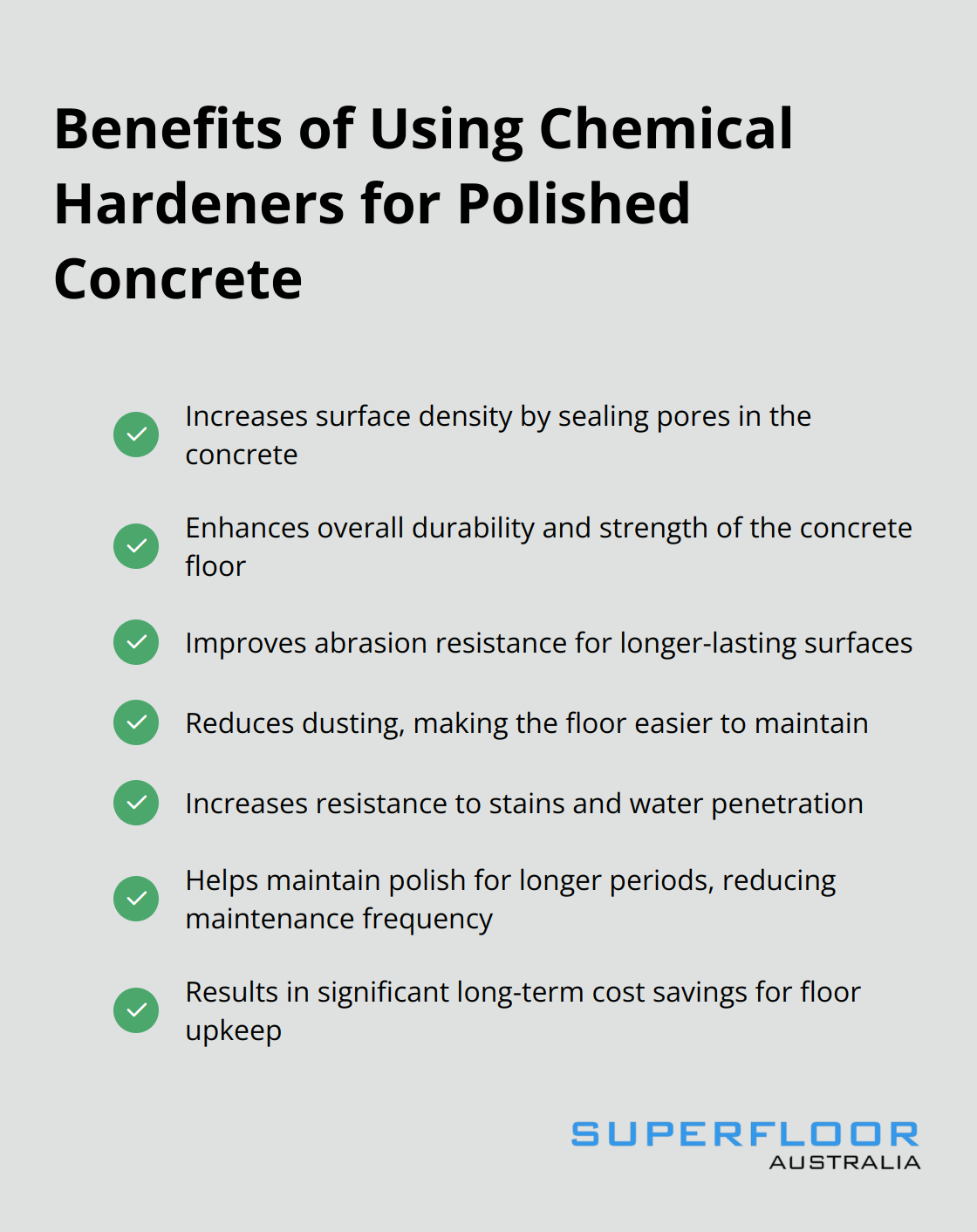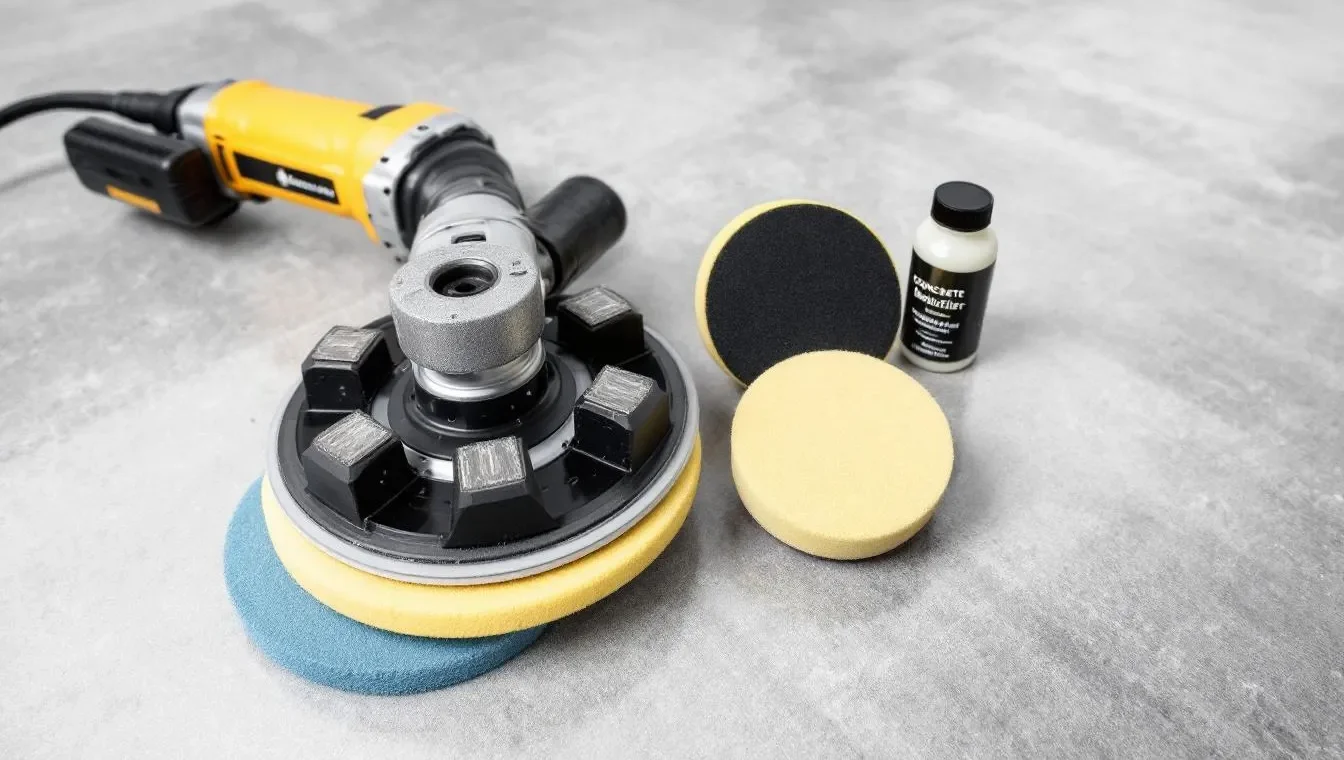At Superfloor Australia, we know that achieving perfect polished concrete floors requires the right tools and materials.
Concrete polishing supplies are the backbone of any successful flooring project. From powerful grinding machines to specialised abrasives and chemical hardeners, each component plays a vital role in the process.
In this post, we’ll explore the essential equipment and products you need to create stunning, durable concrete surfaces that stand the test of time.
Which Machines Are Best for Concrete Grinding and Polishing?
Planetary Grinders: The Industry Standard
Selecting the right concrete grinding and polishing machines is essential for flawless floors. Planetary grinders stand out as the workhorses of the industry. These machines typically feature multiple rotating heads that move in opposite directions, which ensures even coverage and superior results.
Planetary grinders come in various sizes. Larger models (like the HTC 800) offer faster coverage for expansive areas. For smaller spaces or residential projects, compact models in the 20-inch range provide excellent manoeuvrability without sacrificing power.
When selecting a planetary grinder, weight and power output are key factors. Heavier machines (around 600-800 lbs) often deliver more consistent pressure, which results in a more uniform finish. Models with adjustable speed settings (typically ranging from 300 to 1500 RPM) accommodate different stages of the polishing process.
Hand-Held and Edge Grinders: Precision Tools
While planetary grinders handle the bulk of the work, hand-held and edge grinders are indispensable for detail work. These smaller tools allow operators to reach tight corners, work along walls, and tackle stairs or other challenging areas.
Hand-held grinders are a fast solution for smoothing out bumps and other irregularities in both horizontal and vertical concrete surfaces. They can also be used to remove graffiti.
For edge work, a dedicated edge grinder is a worthwhile investment. These machines get as close to walls as possible, which minimises the need for hand grinding and ensures a consistent finish throughout the space.

Key Features to Consider
Dust collection systems are a must-have in modern concrete polishing. Air quality and safety are the most important purposes for dust collection systems, but they also keep the dust off of the floor. Machines with built-in vacuum ports that connect to industrial-grade dust extractors improve air quality, enhance visibility, and reduce cleanup time.
Power source is another critical factor. Electric models are common, but propane-powered grinders offer cordless operation for outdoor projects or areas without reliable power access (however, they require proper ventilation and safety precautions).
Popular Brands in the Industry
Several manufacturers have established themselves as leaders in concrete polishing equipment. Husqvarna (with its Hiperfloor system) offers a comprehensive range of machines and accessories. SASE Company is known for its robust planetary grinders, while Lavina produces innovative edge grinding solutions.
Matching the right machine to the specific project requirements is key to achieving outstanding results. High-end equipment often comes with a higher price tag, but the investment pays off in efficiency, quality, and long-term durability of the polished concrete floors.
Now that we’ve covered the essential machines for concrete grinding and polishing, let’s explore the abrasives and diamond tools that work in tandem with these machines to create the perfect finish.
Choosing the Right Abrasives for Perfect Concrete Polishing
At Superfloor Australia, we know that selecting appropriate abrasives and diamond tools is essential for achieving flawless polished concrete floors. The right choice impacts work efficiency and final result quality significantly.
Metal-Bonded Diamonds: The Initial Grind
Metal-bonded diamond tools start the concrete polishing process. These professional grade concrete grinding discs have high diamond density. Their segments are designed with a forward facing taper for increased life. They excel on harder concrete surfaces.
When tackling an old warehouse floor with deep scratches and uneven areas, a 30/40 grit metal-bonded diamond often proves effective. This coarse grit removes the top concrete layer, exposing a fresh surface for further refinement.
Resin-Bonded Diamonds: Surface Refinement
As polishing progresses, resin-bonded diamond tools take over. These softer abrasives refine the concrete surface and bring out its natural shine. Available in a wide range of grits, they offer versatility for various finishes.
A high-end retail store project might use a sequence of resin-bonded diamonds starting at 100 grit and progressing to 200 grit. These fine grits are typically used in the final stages for fine grinding and polishing of the concrete surface.
Hybrid Diamonds: Adaptable Performance
Hybrid diamond tools combine the durability of metal bonds with the smoothness of resin bonds, offering versatility for mid-range tasks. These versatile abrasives prove particularly useful in transitional polishing stages or when working with varying concrete hardness.
Residential projects often present floors with inconsistent concrete density. Hybrid diamonds allow adaptation to these variations without constant tool switching, saving time and ensuring uniform finishes across entire surfaces.
Grit Progression: The Path to Perfection
The concrete polishing process follows a specific grit progression. This sequence (starting with coarse grits and moving to finer ones) determines the final floor appearance. A typical progression might look like this:
- 30/40 grit (metal-bonded)
- 60/80 grit (metal-bonded)
- 150 grit (hybrid or resin-bonded)
- 300 grit (resin-bonded)
- 800 grit (resin-bonded)
- 1500 grit (resin-bonded)
- 3000 grit (resin-bonded, for ultra-high gloss)
Each step refines the surface further, gradually increasing shine and smoothness.

Quality Considerations
Investing in high-quality diamond tools may seem costly upfront, but it pays off in efficiency and results. Cheaper, low-quality abrasives often wear out quickly, leading to inconsistent finishes and increased labour costs.
Professional-grade abrasives (from reputable manufacturers like Husqvarna or SASE) offer longer life spans and more consistent results. This quality translates directly to the finished floor’s appearance and durability.
The selection of appropriate abrasives forms a critical part of the concrete polishing process. However, achieving truly outstanding results also requires the use of chemical hardeners and densifiers. These products work in tandem with mechanical polishing to enhance concrete durability and appearance.
Why Chemical Hardeners Are Essential for Polished Concrete
The Science of Concrete Densification
Chemical hardeners and densifiers transform the concrete polishing process. A concrete densifier is a chemical solution that, when applied to a concrete surface, increases surface density by sealing pores. This reaction enhances the concrete’s durability, abrasion resistance, and overall strength significantly.
Concrete densifiers fill the porous structure of concrete. This process increases surface hardness, reduces dusting, and improves resistance to stains and water penetration.
Floors treated with quality densifiers maintain their polish longer and require less frequent maintenance. This results in significant cost savings over the life of the floor.

Types of Densifiers
Three main types of concrete densifiers exist: sodium silicate, potassium silicate, and lithium silicate. Each type has its strengths and ideal applications.
Sodium silicate offers the most economical option and works well for many projects. However, it can sometimes leave a white residue on the surface if not applied correctly.
Potassium silicate penetrates deeper into the concrete and is less likely to leave residue. It provides a good middle-ground option in terms of performance and cost.
Lithium silicate represents the premium choice. It reacts faster, penetrates deeper, and is less likely to contribute to alkali-silica reaction (ASR) issues. While it costs the most, its superior performance often justifies the price for high-end projects. Lithium-based densifiers give a more reflective surface compared to sodium silicates, which give a matt finish.
Application Techniques
The timing of densifier application plays a key role in the process. The first coat of densifier should be applied after the initial grinding stages (usually around the 200-grit step). This allows the product to penetrate deeply into the newly exposed pores of the concrete.
For best results, use a low-pressure sprayer to apply the densifier evenly across the surface. Keep the floor wet with the product for about 30 minutes, adding more as needed to maintain saturation. After this, use a microfibre pad to work the densifier into the surface and remove any excess.
A second application often proves beneficial after the 400-grit polishing step. This helps to further densify the surface and prepare it for the final polishing stages.
Avoiding Common Mistakes
Proper application is key to success with chemical hardeners. Overapplication can lead to issues like surface whitening or difficulty in achieving a high polish. Try to apply multiple light coats rather than one heavy coat.
The use of high-quality chemical hardeners and densifiers (from reputable manufacturers) is non-negotiable for achieving truly outstanding polished concrete floors. They provide the durability and shine that clients expect from a professional polishing job.
Final Thoughts
Creating perfect polished concrete floors requires skill, experience, and the right concrete polishing supplies. Professional-grade equipment and materials are essential for outstanding results. High-quality planetary grinders, hand-held tools, and edge grinders form the foundation of any successful polishing project.
These machines, paired with appropriate diamond abrasives and chemical hardeners, allow for precise control over the polishing process. They ensure long-lasting, beautiful floors that maintain their lustre for years. Top-tier concrete polishing supplies often prove more cost-effective in the long run, offering increased durability and improved efficiency.
Every project has unique requirements, so we encourage you to consult with experts for personalised advice. At Superfloor Australia, we specialise in delivering high-quality polished concrete flooring in Brisbane (enhancing both aesthetics and durability). Our team’s expertise, combined with state-of-the-art equipment and materials, ensures exceptional results for homes, commercial spaces, and industrial environments.
